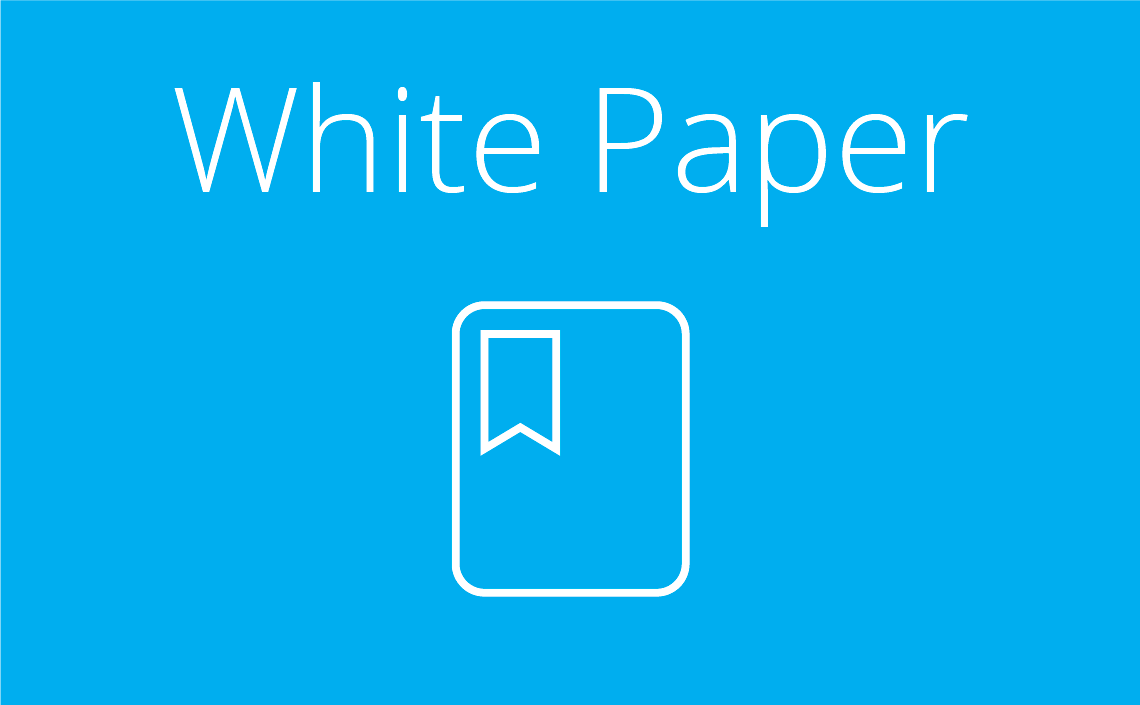Praxis EMR v5 White Paper
Freeing Doctors from Third-Party Requirements.
I took the road less traveled by, and that
has made all the difference."
Robert Frost
The road less traveled
Physicians are at a crossroads. Like the traveler in Robert Frost's celebrated poem, "The Road Not Taken," today's providers must make a fundamental decision: whether to purchase a template-based EMR (which is what most electronic charting systems are) or to choose a more innovative solution-the road less traveled. The decision they make will have a profound effect on their practice of medicine.
The well-traveled road is littered with templates. The makers of template-based EMRs assume that medicine can be broken down into various diagnoses and disease entities. But, medicine is not that simple. At issue is that template-based systems do not address the most critical problem facing doctors: the time wasted on medical documentation. In fact, template-based EMRs slow down charting, increase malpractice risk, and lead to professional stress. Even worse, templates force patients into inflexible molds, resulting in lower medical quality. This explains why doctors have been reluctant to adopt EMRs, and why templates are being given away for free.
Praxis EMR started on the road less traveled over twenty years ago. Throughout its development, Praxis has been guided by one goal: to develop a template-free EMR that empowers physicians to chart faster, better, and easier. Because Praxis EMR works with free text rather than templates, doctors chart in their own words. And, because of its unique artificial intelligence engine, Praxis gets smarter and faster the more it is used.
The power of Praxis has attracted companionship on the road less traveled. Praxis is certified for Meaningful Use, has won prestigious awards, and enjoys the passionate support of thousands of brilliant physician-users, whose collective experiences continue to enrich Praxis EMR today.
How Praxis Works
Praxis EMR is based on a simple premise: Medicine is an art.
This means that no two doctors practice medicine the same way. Every physician brings a unique and personal touch to the way a patient is treated.
However, all practitioners do have one very important thing in common. Every doctor, no matter what specialty of medicine, sees certain cases more often than others.
Praxis EMR finds the closest case to anything a provider has ever seen, and writes the new encounter in a physician's own words, automatically. Praxis generates the note instantly, complete with instructions to patient and staff, prescriptions, admitting orders, procedure reports, letters to referring providers, office or school excuses, and even an optimal coded superbill. The doctor is seeing the next patient!
There are no templates in Praxis EMR, and this allows a provider to chart progressively faster while at the same time improving the quality of medicine delivered to patients.
The Praxis Knowledge Exchanger
Getting started with Praxis is easy. The Praxis Knowledge Exchanger allows users to import libraries of medical knowledge, crafted from years of real-life medical learning for real-time use. Physicians instantly benefit from the medical knowledge of their peers and experts, while at the same time maintaining a completely separate knowledge base that self-learns.
At Praxis, physician clients in all specialties have made their knowledge bases available to the community of Praxis EMR users. Further, Praxis users can share their knowledge bases directly with each other. Praxis Clinics with multiple doctors now enjoy Praxis Knowledge Networks that constantly improve the medical quality of all physicians connected to the clinic's network.
Praxis v5: Handling discrete data discreetly
In the era of Meaningful Use, the challenge for Praxis EMR was meeting the government's discrete data demands while preserving our free text approach, the key to Praxis EMR's usability. This challenge led to a suite of new innovations that elegantly address Meaningful Use reporting requirements.
More importantly, Praxis EMR v5 handles discrete data discreetly, so that it does not interfere with the practice of medicine. It also generates discrete data that is more reliable than what templates produce, making Praxis superior for purposes of interoperability and sophisticated medical queries.
Embedding Discrete Data in Free TextPraxis v5 introduces Datum, a feature that allows the user to embed discrete data directly into free text. Whenever a phrase that includes Datum elements is used in a patient note, the Datum elements pull the appropriate discrete data directly from the database. For instance, the patients name, age and gender will be pulled from the demographics, while the lab values and dates will be pulled from the lab reports. In the screen capture one sees how a phrase with Datum elements appears in the final note.
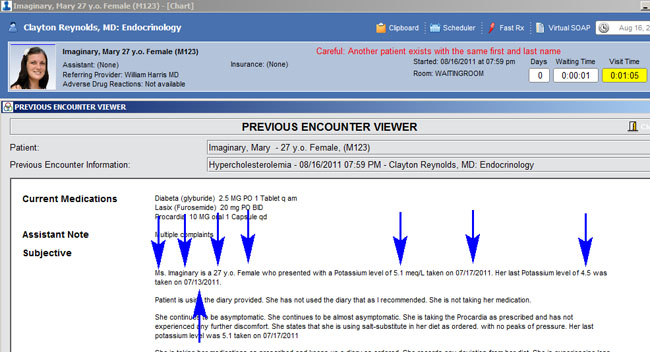
When used in a patient chart, the Datum elements pull the discrete data directly from the database, instantly populating the patient note with the right information.
Once you set up a phrase with Datum elements, you can use it over and over again with the same or any other patient. Datum pulls the appropriate discrete data from other areas of that patient's chart and populates the text automatically.
With Datum, one is not limited to simple incoming data. One may also create formulas to automatically operate on any numeric data, so as to generate more meaningful clinical information instantly. No longer will a doctor need to calculate BMIs, Creatinine Clearances, Anion Gaps or any other value. Use Datum to create the formula once, place it wherever you need it in the record, and Praxis does the calculations for you automatically from then on, on that patient and any other.
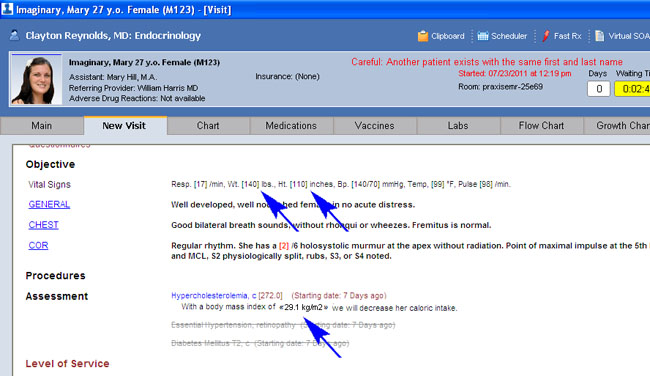
An embedded Datum formula instantly shows the BMI, calculated from the height and weight included in another area of the patient chart.
The Concept Processor guarantees that the next time another patient presents with the same problem, all the data fields will be instantly populated in the same manner for that new patient as well. The user does it once, and Praxis handles it automatically forever.
Datum's combination of flexibility and minimal need for data entry makes it perfect for meeting any present or future third party requirements with ease.
Revolutionizing Medical Research
Praxis v5 introduces the most powerful query engine in medicine.
With Praxis EMR v5, the physician has the ability to create any query desired, as Praxis operates free of the constraints of templates. This flexibility makes Praxis perfect for any clinical study, including drug trials and sophisticated multi-center clinical investigations. It also makes it very easy for a provider to comply with all reporting requirements, including all of the clinical quality measures required under Meaningful Use, without burdening the busy practitioner.
Additionally, queries created in Praxis v5 can be exported and shared with others, allowing clinics and third parties to develop specialized queries for others to use. The ability to create any practice guideline on the fly and to query any kind of clinical information will revolutionize medical studies, allowing researchers to easily create their own queries and gather data prospectively as well as retrospectively.
The Query Builder feature in Praxis v5 allows a doctor to develop queries based on the values and parameters of one's own choosing without requiring programmers or technicians. One can map queries by linking data tables or write queries by using Standard Query Language, an easily accessible computer language.
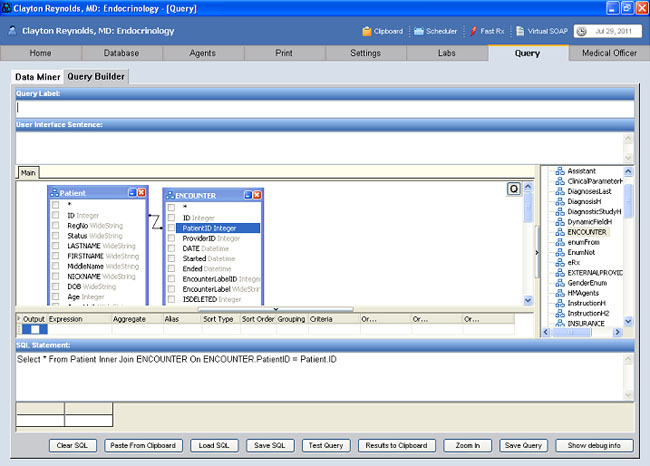
Linking patient and encounter information to find which patients present with certain criteria. You can query for any type of criteria you wish to measure.
Once a given query is created, it can then be executed by anyone in the clinic using the DataMiner. Simply click on the query and the DataMiner takes over, instantly retrieving the reports needed.
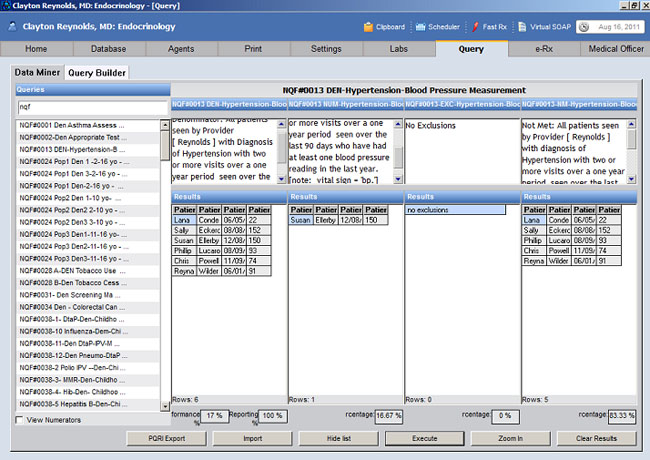
PQRI Queries. Just about anyone with medical knowledge and a modicum of SQL language experience can create any query desired. These results can then be used by anyone in the clinic to instantly comply with Medicare requirements. The query engine can retrieve very complex information to improve a medical practice and to generate prospective and retrospective statistical data for medical research. Praxis v5 contains the most powerful practice guideline and query engine in medicine.
The DataMiner is able to execute any query conceivable. Reports can then be exported into a variety of formats, including Microsoft Excel, Microsoft Word, HTML, and XML as required by Meaningful Use. The DataMiner automatically reports the denominators, numerators, and exclusions, and automatically calculates the resulting percentages for Meaningful Use purposes.
The data generated by Praxis v5 is superior to data generated by template-based systems because the source of the data is real and not the product of a busy practitioner entering data into multiple pick-lists while seeing many complex cases in a short time span.
Automating Workflow
With Praxis EMR, the chart comes alive!
Using Praxis Agents, the chart "talks" to the clinical staff, making it possible to automate a clinic's workflow.
Agents are messengers that are placed directly into the patient note. Agents are 'intelligent' and know exactly when they need to activate themselves and who in the clinic they need to reach.
The user may set Agents to activate days, weeks, even months later. For instance, an Agent can be used to remind staff to call a patient and schedule a repeat MRI. Alternatively, Agents can be triggered under certain conditions, such as the next time a patient returns to the clinic. When the conditions exist, the Agent will know whom to inform and when, making the appropriate adjustment even in the case of staff turnover.
The best part of Agents is that the physician creates them only once. The next time the doctor sees a patient with a similar condition, the Agent will be right there, within the chart, ready to perform the same task for that new patient as well. The provider can easily modify any Agent, and then that new Agent will be instantly available the next time it is needed. The more Agents one creates, the more the chart seems to take on a life of its own.
Improving the Quality of Medicine
Clinical Practice Advisories provide medical advice, even entire treatment protocols, at the point of care. They work like Agents, triggered when a patient meets certain criteria determined by the Medical Officer of the practice.
Clinical Practice Advisories may be triggered by demographic information (such as age, race, gender, employer, insurance plan, etc.), ICD10 diagnoses, CPT treatments, laboratory values, prescribed medications, vital signs, and any other clinical parameter, including calculations based on Datum elements (i.e., women with a Body Mass Index greater than a certain value).
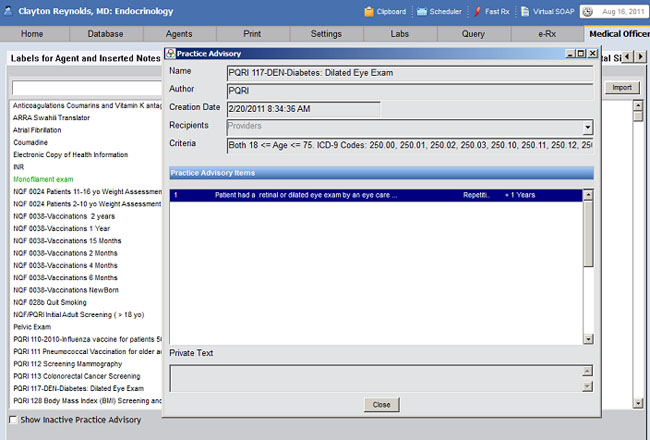
The Clinical Practice Advisory shown here is set to trigger whenever a doctor sees a patient between the ages of 18 and 75 with an ICD10 diagnosis of diabetes.
Like Agents, Clinical Practice Advisories are also directed to specific members or groups of members on the staff (i.e., all assistants, all providers, all cardiologists, etc.).
Additionally, a recommendation may make its reappearance at the point of care with a given frequency (i.e., "Repeat dilated eye exam once a year").
Further, Clinical Practice Advisories can be written as fait-accompli statements (i.e., "I have referred the patient for her yearly Ophthalmology Dilated Eye exam for diabetes"). In this way, all the provider needs to do at the point of care is click on the Advisory and the doctor has just complied and documented the action all at the same time!
This is particularly useful for Meaningful Use compliance. By writing Clinical Practice Advisories as fait-accompli statements (for example, "Did you advise patient to quit smoking?" becomes "I advised patient to quit smoking."), one records the data for the purposes of Meaningful Use reporting while also ensuring that the score will be 100%! With Praxis, Meaningful Use reporting does not become a burden, but rather a helpful aid at the point of care.
Using Clinical Practice Advisories improves the quality of medicine delivered to patients.
Meaningful use: Praxis scores 100% without effort!
Every certified EMR is able to send and receive required Meaningful Use data without difficulty. But only Praxis EMR does so in the background, so the provider's Meaningful Use reporting is automated.
At Praxis, we understand that doctors will experience various Meaningful Use stages. In the initial stage, they will be asked to supply information on clinical indicators in order to develop the best-practice guidelines.
In the later stages, incentives and fines will be used to drive physicians to practice medicine according to the developed guidelines.
Under the Meaningful Use requirements, the doctor will be required to respond to queries in a format such as this:
For all patients seen in the last X months who exhibited Y condition for at least Z months, how many presented W results/treatments?
Here is an example of how clinical data would be reported using this format:
For all patients seen in the last 18 months who are over the age of 65, how many received the influenza vaccination during the period [START DATE] to [END DATE].
Note that each of these questions is rhetorical in nature, representing an implied performance measure and, thus, a practice guideline (i.e. Every patient over the age of 65 should be vaccinated against influenza during the flu season unless specifically contraindicated).
The data needs to be reported electronically to Medicare using codes designed for this purpose. For any EMR, this is a straightforward task. The only thing that is needed is for someone to input the data. That someone is the physician at the point of care. Doctors will have to enter information in a data field for every patient that meets the criteria, and to do it year after year. What physician has the time for this?
With Praxis, Meaningful Use and all other reporting is automated. There is never any need to repeatedly fill out a template. Praxis insures 100% compliance as well as reimbursements. No other system does this.
Optimized reimbursements
With the new PraxCoder, doctors will never under-code again. The PraxCoder offers Level-of-Service advice with instant documentation to earn the optimum reimbursement the physician rightly deserves. Providers are informed of the optimal Level of Service based on procedures, diagnoses, and plan elements, including time spent with the patient where applicable. The PraxCoder then walks the user through what must be completed in the H&P to attain the optimal level of re-imbursement available for the visit.
Interoperability
Often, Health IT systems designed for large institutions do not address the needs of provider clinics. Prior to federal regulations and interoperability standards, practitioners affiliated with health institutions were forced to adapt the same systems as the institution itself. This is no longer the case.
The flexibility with which Praxis v5 handles discrete data makes it possible for a practitioner to share any reporting data with any legacy system. That means, no matter what others are using, a Praxis user can interface to the system.
Praxis EMR v5 fulfills all interoperability requirements by employing the latest HL7 Standard to easily and effectively transfer clinical data via the Clinical Document Architecture (CDA) as well as the Continuity of Care Document (CCD) that will be used to share clinical information across diverse EMRs.
Improving physicians' lives
Praxis has come a long way on the road less traveled. Each step has led to new innovations, as our clients imagine the limitless potential of template-free charting. Throughout the journey, we have never forgotten where we are headed. Praxis EMR will always be about helping the doctor chart faster, easier, and better.
As we've seen, charting template-free offers physicians several key benefits, the most significant of which are:
Speed
It takes a doctor less than a minute to finish a chart with Praxis EMR. This is because, with Praxis, the physician is interacting with his or her own medical concepts. It is much easier for one to read and quickly grasp what one wrote rather than what someone else wrote. In addition, Praxis presents all the medical information required, exactly how it is wanted, where it is needed, and without any errors.
Quality
With Praxis EMR, providers are constantly refining their approach to medicine. Ask a patient a question once and Praxis will remind the doctor to ask that question every time a similar case is seen. This helps ensure that one delivers the highest quality of medicine to all patients, no matter how busy the doctor's schedule.
Legal protection
Quality documentation is the best defense in a legal proceeding. Praxis patient notes reflect the provider's medical thinking and preserves the personal style brought to the assessment, thus preventing the prosecution from alleging that a doctor practices cookie-cutter medicine. Additionally, Praxis patient notes are protected under physician-patient confidentiality because they are not the creation of the software, but rather are based on the examination of actual patients.
Less personal stress
Praxis EMR works with the mind of the physician, helping the doctor every step of the way. With Praxis, doctors have more time to spend with patients and need not spend time after-hours finalizing charts. Doctors also won't wake up in the middle of the night, suddenly realizing they forgot to tell a patient something important. Medical practitioners breathe easier with Praxis EMR.
Today, physicians stand at a crossroads, faced with a choice. But, they are not alone on the road to Electronic Medical Records adoption. Although they face diverging paths, fortunately they are able to benefit from the experiences of those who have gone before. In this era of Meaningful Use, an Electronic Medical Record will help determine whether a provider remains a thinking, independent, and creative practitioner of medicine, or whether one simply becomes a technician or data entry clerk, following dictates from a template.
We invite all clinics to join us on the road less traveled, and fall in love with the Art of Medicine all over again.
